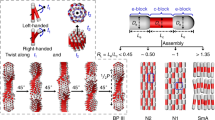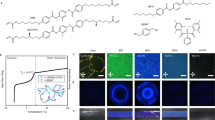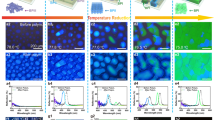Abstract
When liquid crystal molecules are chiral, the twisted structure competes with spatially uniform liquid crystalline orders, resulting in a variety of modulated liquid crystal phases, such as the cholesteric blue phase1, twist grain boundary2,3,4 and smectic blue phases5. Here we report a liquid crystal smectic blue phase (SmBPiso), formed from a two-component mixture containing a chiral monomer and a ‘twin’ containing two repeat units of the first molecule connected by a linear hydrocarbon spacer. The phase exhibits the simultaneous presence of finite local-order parameters of helices and smectic layers, without any discontinuity on a mesoscopic length scale. The anomalous softening of elasticity due to a strong reduction in entropy caused by mixing the monomer and the twin permits the seamless coexistence of these two competing liquid crystal orders. The new phase spontaneously exhibits an optically isotropic but uniformly iridescent colour and automatically acquires spherical symmetry, so that the associated photonic band gap6,7,8,9 maintains the same symmetry despite the local liquid crystalline order. We expect a range of unusual optical transmission properties based on this three-dimensional isotropic structure, and complete tunability due to the intrinsic softness and responsiveness of the liquid crystalline order against external fields.
This is a preview of subscription content, access via your institution
Access options
Subscribe to this journal
Receive 51 print issues and online access
$199.00 per year
only $3.90 per issue
Buy this article
- Purchase on Springer Link
- Instant access to full article PDF
Prices may be subject to local taxes which are calculated during checkout




Similar content being viewed by others
References
Ketzerow, H. S. & Bahr, C. (eds) Chirality in Liquid Crystals 186–222 (Springer, New York, 2002)
Renn, S. R. & Lubensky, T. C. Abrikosov dislocation lattice in a model of the cholesteric-to-smectic A transition. Phys. Rev. A. 38, 2132–2147 (1988)
Goodby, J. W. et al. Characterization of a new helical smectic liquid crystal. Nature 337, 449–452 (1989)
Dierking, I. & Lagerwall, S. T. A review of textures of TGB* phase under different anchoring conditions. Liq. Cryst. 26, 83–95 (1999)
Pansu, B., Grelet, E., Li, M. H. & Nguyen, H. T. Hexagonal symmetry for smectic blue phases. Phys. Rev. E 62, 658–665 (2000)
John, S. Electromagnetic absorption in a disordered medium near photon mobility edge. Phys. Rev. Lett. 53, 2169–2172 (1984)
Yablonovitch, E. Inhibited spontaneous emission in solid-state physics and electronics. Phys. Rev. Lett. 58, 2059–2062 (1987)
John, S. Strong localization of photons in certain disordered dielectric superlattices. Phys. Rev. Lett. 58, 2486–2489 (1987)
Busch, K. & John, S. Liquid-crystal photonic-band-gap materials: the tunable electromagnetic vacuum. Phys. Rev. Lett. 83, 967–970 (1999)
Nishiyama, I., Yamamoto, J., Goodby, J. W. & Yokoyama, H. Symmetric chiral liquid crystalline twin exhibiting stable ferroelectric and antiferroelectric phases and a chirality-induced isotropic-isotropic liquid transition. J. Mater. Chem. 11, 2690–2693 (2001)
Yamamoto, J. & Okano, K. Anomalous hydrodynamic behaviors of smectic liquid crystals at low frequencies. Jpn. J. Appl. Phys. 30, 754–763 (1991)
DiDonna, B. A. & Kamien, R. D. Smectic phases with cubic symmetry: the splay analog of the blue phase. Phys. Rev. Lett. 89, 215504 (2002)
Yamamoto, J. & Tanaka, H. Transparent nematic phase in liquid-crystal based microemulsion. Nature 409, 321–325 (2001)
MacKintosh, F. C. & Lubensky, T. C. Orientational order, topology, and vesicle shapes. Phys. Rev. Lett. 67, 1169–1173 (1991)
Zhong-can, O. & Ji-xing, L. Helical structure of tilted chiral lipid bilayers viewed as cholesteric liquid crystals. Phys. Rev. Lett. 65, 1679–1682 (1990)
Niori, T., Sekine, T., Watanabe, J., Furukawa, T. & Takezoe, H. Distinct ferroelectric smectic liquid crystals consisting of banana shaped achiral molecules. J. Mater. Chem. 6, 1231–1233 (1996)
Thisayukta, J., Takezoe, H. & Watanabe, J. Study on helical structure of the B4 phase formed from achiral banana-shaped molecules. Jpn. J. Appl. Phys. 40, 3277–3287 (2001)
Acknowledgements
We thank L. Hough and N. A. Clark for suggesting methods of preparing the frozen replica of the TEM observation.
Author information
Authors and Affiliations
Corresponding author
Ethics declarations
Competing interests
Reprints and permissions information is available at npg.nature.com/reprintsandpermissions. The authors declare no competing financial interests.
Supplementary information
Supplementary Figure S1
A freeze-fracture replica of the TEM photograph of a fractured SmBPIso. The scale bar corresponds to 1 µm. We would like to emphasize that the fractured surface profile represents the spatial distribution of the layers since they can be fractured easily along the plane of the layers. (JPG 130 kb)
Supplementary Figure S2
A magnified photograph of Supplementary Fig. S1. The scale bar corresponds to 200 nm. The thin string-like pattern indicates that the interconnected structure was formed by the multi-layer bundle. (JPG 122 kb)
Supplementary Figure S3
A frozen replica of the TEM photograph of the free air interface of SmBPIso. The scale bar corresponds to 1 µm. The surface step of the smectic layer curved automatically and formed a wavy structure due to the bulk of the multi-lamellar interconnected structure. (JPG 128 kb)
Rights and permissions
About this article
Cite this article
Yamamoto, J., Nishiyama, I., Inoue, M. et al. Optical isotropy and iridescence in a smectic ‘blue phase’. Nature 437, 525–528 (2005). https://doi.org/10.1038/nature04034
Received:
Accepted:
Issue Date:
DOI: https://doi.org/10.1038/nature04034
Comments
By submitting a comment you agree to abide by our Terms and Community Guidelines. If you find something abusive or that does not comply with our terms or guidelines please flag it as inappropriate.



